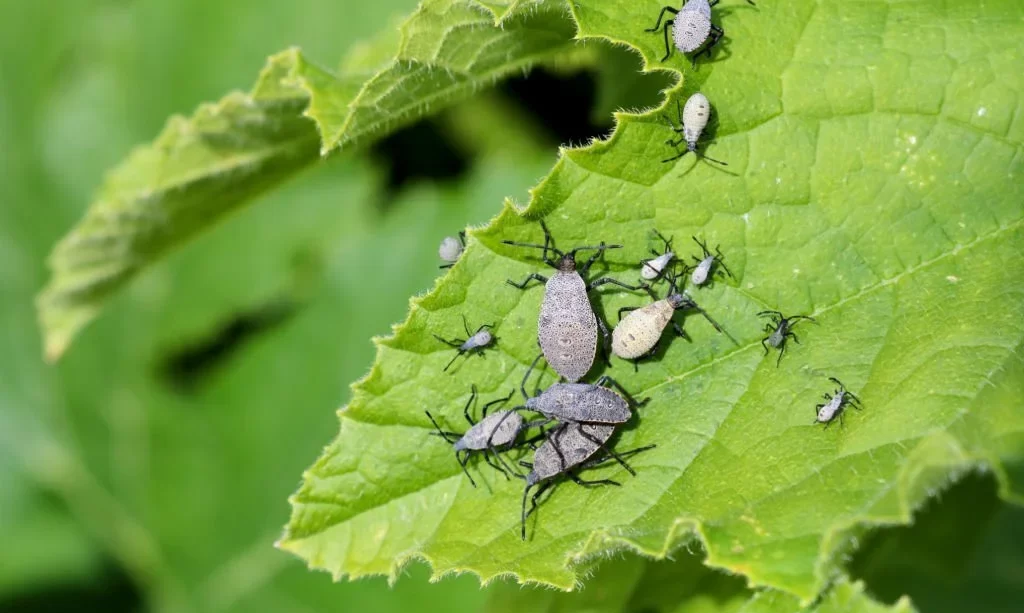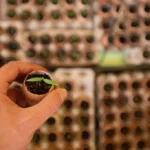Squash bugs, those persistent pests that can wreak havoc in your garden, have a life cycle that includes overwintering. Overwintering is a critical phase for these insects, as it determines whether they’ll return in force the next growing season. Preventing squash bugs from successfully overwintering is an essential step in safeguarding your garden’s health and productivity. In this article, we’ll delve into the world of squash bugs, exploring their life cycle and the reasons why overwintering is a significant concern for gardeners. We’ll also provide you with a comprehensive guide on how to thwart their overwintering efforts effectively, ensuring a healthier and more bountiful garden in the seasons to come.
Squash Bugs
To effectively combat squash bugs and prevent them from overwintering, it’s crucial to grasp their characteristics and life cycle:
- Appearance: Squash bugs are brown or grayish insects with flat bodies and elongated shapes. They measure about 1/2 to 3/4 inch in length. Adults have distinctive wings with alternating black and white patterns on the edges.
- Life Cycle: Squash bugs undergo several stages in their life cycle, including eggs, nymphs, and adults. They typically lay their bronze-colored, oval-shaped eggs in neat rows on the undersides of leaves. Once hatched, the nymphs pass through five developmental stages before reaching adulthood.
- Diet: These pests primarily feed on members of the cucurbit family, including squash, pumpkins, zucchini, and cucumbers. They pierce plant tissues with their needle-like mouthparts, extracting sap and causing wilting, yellowing, and eventual plant decline.
- Overwintering: As temperatures drop in the fall, squash bugs seek shelter to overwinter. They hide in protected locations such as garden debris, dead plant material, and nearby structures. Overwintering allows them to survive harsh conditions and emerge in the spring to continue their life cycle.
Understanding the various stages of a squash bug’s life cycle, as well as their preferred hiding spots during the winter months, is essential for effective prevention strategies. In the sections that follow, we will delve deeper into practical methods and techniques to deter squash bugs from successfully overwintering in your garden.
Identifying Overwintering Sites
To effectively prevent squash bugs from overwintering, you must first identify the common hiding spots they seek during the winter months:
- Garden Debris: Squash bugs often seek refuge in garden debris, including fallen leaves, dead plant material, and discarded branches. These areas provide shelter and insulation from the cold.
- Plant Debris: Fallen leaves and decaying plant matter on the soil surface create ideal hiding spots. Squash bugs can burrow into this debris to stay protected from winter weather.
- Nearby Structures: Squash bugs are resourceful pests and may also find shelter in structures close to your garden, such as sheds, compost bins, or wooden fences. Gaps and crevices in these structures can provide convenient hiding spots.
- Garden Equipment: Unused garden equipment, such as pots, trellises, and gardening tools, can harbor squash bugs. Inspect and clean these items thoroughly to reduce potential hiding places.
Fall Cleanup and Removal
One of the most effective ways to prevent squash bugs from successfully overwintering is through thorough fall cleanup and removal:
- Remove Garden Debris: Begin by removing fallen leaves, dead plants, and any garden debris that may have accumulated during the growing season. Dispose of this material away from your garden to eliminate potential hiding spots.
- Clear the Soil Surface: Rake the soil surface to clear away decaying plant matter and leaves. This not only removes hiding places but also exposes any squash bug eggs that may be present.
- Prune Dead Plant Material: Trim and prune dead or diseased plant material, especially on cucurbit plants. Removing these sources of food and shelter reduces the attractiveness of your garden to squash bugs.
- Clean Nearby Structures: Inspect and clean structures near your garden, such as sheds or compost bins, to eliminate potential squash bug hiding spots. Seal any gaps or crevices where they could enter.
Soil Preparation and Amendments
Preparing the soil and making strategic amendments can create an environment that is less hospitable to overwintering squash bugs:
- Till the Soil: Tilling the soil in your garden can disrupt squash bug habitats and expose them to the elements. Turn over the soil to disturb any bugs hiding beneath the surface.
- Use Soil Amendments: Consider incorporating diatomaceous earth into the soil. This natural substance is abrasive to insects and can deter squash bugs from burrowing into the ground.
- Apply Beneficial Nematodes: Beneficial nematodes are microscopic organisms that can be added to the soil. They prey on squash bug eggs and larvae, reducing their populations before winter.
- Avoid Excessive Mulching: While mulch can be beneficial during the growing season, avoid excessive mulching in the fall. Thick layers of mulch can create additional hiding places for squash bugs.
By identifying overwintering sites, conducting a thorough fall cleanup, and preparing the soil with strategic amendments, you can significantly reduce the chances of squash bugs successfully overwintering in your garden. In the following sections, we’ll explore additional techniques and methods to bolster your defense against these persistent garden pests.
- Earthborn Elements Diatomaceous Earth in a resealable bucket
- Packaged in USA
- Pure & Undiluted: Never any additives or fillers
- Diatomaceous Earth is a natural source of freshwater amorphous silica
Mulching and Crop Rotation
Mulching and crop rotation are effective strategies for preventing squash bugs from overwintering:
- Mulching: While mulch can be beneficial during the growing season, it’s essential to use it judiciously in the fall. Excessive mulch can create cozy hiding spots for squash bugs. If you choose to mulch, use a thin layer of materials like straw or wood chips, and ensure it doesn’t accumulate around plant bases. This can discourage squash bugs from laying their eggs and seeking shelter.
- Crop Rotation: Crop rotation is a powerful tool in pest management. Since squash bugs tend to return to the same location each year, rotating your crops can disrupt their life cycle. Plant cucurbit crops in a different area of your garden each season, making it more challenging for overwintered squash bugs to locate their preferred plants. This simple practice can help break the cycle of infestations.
Natural Predators and Beneficial Insects
Encouraging natural predators and beneficial insects in your garden can help keep squash bug populations in check:
- Birds: Attracting birds to your garden can be an effective natural pest control method. Birds like sparrows, swallows, and wrens are known to feed on squash bugs and their eggs. Provide birdhouses, bird feeders, and clean water sources to entice these feathered allies.
- Ladybugs: Ladybugs are voracious predators of aphids and other garden pests, including squash bug nymphs. Planting flowers like marigolds and dill can attract ladybugs to your garden.
- Parasitic Wasps: Certain parasitic wasps lay their eggs inside squash bug eggs, effectively destroying them. Planting nectar-rich flowers like asters can attract these beneficial wasps to your garden.
Trap Crops and Barriers
Implementing trap crops and physical barriers can divert squash bugs away from your main crops and prevent them from overwintering:
- Trap Crops: Planting trap crops, such as varieties of squash or zucchini that are particularly attractive to squash bugs, can lure the pests away from your main cucurbit plants. Keep a close eye on the trap crops and treat or remove the pests from them regularly.
- Row Covers: Physical barriers like row covers made of lightweight fabric can shield your plants from squash bugs and other pests. Ensure the covers are securely anchored to the ground to prevent pests from crawling beneath them. Row covers also have the added benefit of protecting plants from frost.
- Sticky Traps: Place sticky traps around your garden to capture adult squash bugs. These traps are coated with a sticky substance that insects adhere to when they come into contact with it. While they may not eliminate all squash bugs, they can help reduce the population.
Implementing these strategies, from mulching and crop rotation to encouraging natural predators and deploying trap crops and barriers, can significantly reduce the risk of squash bugs successfully overwintering in your garden. In the following sections, we will explore additional organic pest control methods and monitoring techniques to bolster your defense against these persistent garden pests.
Organic Pest Control Methods
Organic pest control methods can be highly effective in deterring squash bugs and minimizing their overwintering success:
- Neem Oil: Neem oil is a natural and organic insecticide that can be applied to plants. It disrupts the feeding and reproductive abilities of squash bugs and other garden pests.
- Insecticidal Soap: Insecticidal soaps are safe for plants and humans but can be deadly to squash bugs. They work by suffocating the insects upon contact. Regularly spraying affected plants can help control the population.
- Beneficial Nematodes: Beneficial nematodes, applied to the soil, can target squash bug eggs and larvae. These microscopic organisms are natural predators that can reduce overwintering populations.
- Garlic Spray: Garlic spray can be used as a deterrent. Blend garlic cloves with water, strain the mixture, and spray it on plants. The strong odor can discourage squash bugs from settling.
- Pyrethrin: Derived from chrysanthemum flowers, pyrethrin-based insecticides are effective against squash bugs. They break down quickly in the environment and can be used as part of an organic pest management strategy.
Monitoring and Early Detection
Vigilant monitoring and early detection are key to preventing squash bugs from overwintering successfully:
- Regular Inspections: Consistently inspect your plants for signs of squash bugs, including the presence of adults, nymphs, or eggs on the undersides of leaves.
- Egg Removal: If you discover squash bug eggs, remove them promptly to prevent hatching. You can use a piece of tape or a small brush to lift the eggs from the leaves.
- Nymph Removal: Handpick squash bug nymphs and adults and drop them into a bucket of soapy water. This manual removal method can be highly effective, especially when performed consistently.
- Record Keeping: Keep records of when you first spot squash bugs in your garden. Early detection can help you take immediate action to prevent infestations.
Conclusion
Preventing squash bugs from successfully overwintering is a crucial step in maintaining a healthy and productive garden. By understanding the habits and preferences of these garden pests and implementing a combination of strategies, you can significantly reduce their overwintering success.
As a dedicated gardener, you have a range of organic pest control methods at your disposal, from neem oil and garlic spray to beneficial nematodes and natural predators. Regular monitoring and early detection are your allies in this ongoing battle against squash bugs, allowing you to take swift action and protect your garden from infestations.
By combining these approaches, practicing good garden hygiene, and remaining vigilant throughout the growing season, you can enjoy a thriving and pest-free garden year after year. Your commitment to organic and proactive pest management will yield healthier plants, bountiful harvests, and a more enjoyable gardening experience.






